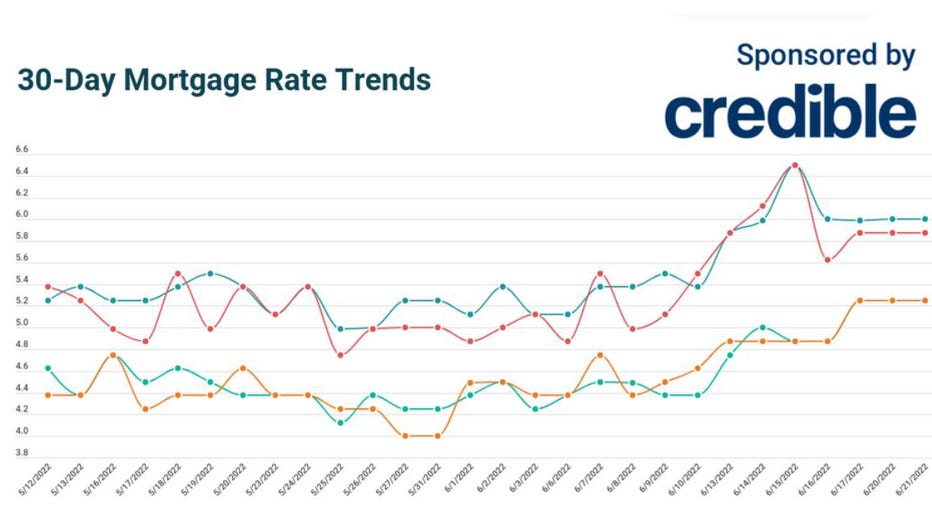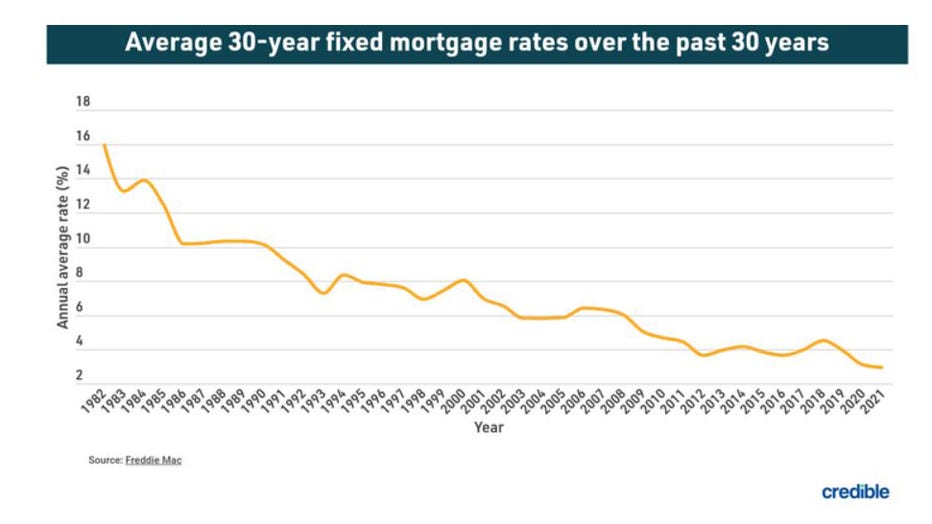Today’s mortgage rates: Largely stable since Friday | June 21, 2022
Our goal here at Credible Operations, Inc., NMLS Number 1681276, referred to as "Credible" below, is to give you the tools and confidence you need to improve your finances. Although we do promote products from our partner lenders, all opinions are our own.

Check out the mortgage rates for June 21, 2022, which are largely unchanged from Friday.
Based on data compiled by Credible, mortgage refinance rates are a mixed bag since Friday.
- 30-year fixed-rate refinance: 6.000%, up from 5.990%, +0.010
- 20-year fixed-rate refinance: 6.000%, down from 6.125%, -0.125
- 15-year fixed-rate refinance: 5.250%, up from 5.000%, +0.250
- 10-year fixed-rate refinance: 5.250%, unchanged
Rates last updated on June 21, 2022. These rates are based on the assumptions shown here. Actual rates may vary. With 5,000 reviews, Credible maintains an "excellent" Trustpilot score.
What this means: At 5.250%, both 15-year and 10-year rates will deliver lower interest costs over the life of a loan. But homeowners who want a longer repayment term still stand to save with 30- and 20-year rates, which are still lower than rates for other home improvement financing options like a credit card or personal loan.
Today’s mortgage rates for home purchases
Based on data compiled by Credible, mortgage rates for home purchases largely held steady since Friday, with the exception of 30-year rates, which edged up slightly.
- 30-year fixed mortgage rates: 6.000%, up from 5.990%, +0.010
- 20-year fixed mortgage rates: 5.875%, unchanged
- 15-year fixed mortgage rates: 5.250%, unchanged
- 10-year fixed mortgage rates: 5.250%, unchanged
Rates last updated on June 21, 2022. These rates are based on the assumptions shown here. Actual rates may vary. Credible, a personal finance marketplace, has 5,000 Trustpilot reviews with an average star rating of 4.7 (out of a possible 5.0).
What this means: After spiking immediately following the Fed’s June 14 interest rate hike, today’s mortgage rates have mostly stuck at Friday’s levels. Only 30-year interest rates increased slightly to 6%. Buyers who can swing a larger monthly mortgage payment will find the most interest savings with shorter repayment terms. Those seeking more time to repay their mortgage might want to consider 20-year rates, which held steady below 6% since Friday.
To find great mortgage rates, start by using Credible’s secured website, which can show you current mortgage rates from multiple lenders without affecting your credit score. You can also use Credible’s mortgage calculator to estimate your monthly mortgage payments.
How mortgage rates have changed over time
Today’s mortgage interest rates are well below the highest annual average rate recorded by Freddie Mac — 16.63% in 1981. A year before the COVID-19 pandemic upended economies across the world, the average interest rate for a 30-year fixed-rate mortgage for 2019 was 3.94%. The average rate for 2021 was 2.96%, the lowest annual average in 30 years.
The historic drop in interest rates means homeowners who have mortgages from 2019 and older could potentially realize significant interest savings by refinancing with one of today’s lower interest rates. When considering a mortgage or refinance, it’s important to take into account closing costs such as appraisal, application, origination and attorney’s fees. These factors, in addition to the interest rate and loan amount, all contribute to the cost of a mortgage.

Are you looking to buy a home? Credible can help you compare current rates from multiple mortgage lenders at once in just a few minutes. Use Credible’s online tools to compare rates and get prequalified today.
Thousands of Trustpilot reviewers rate Credible "excellent."
How Credible mortgage rates are calculated
Changing economic conditions, central bank policy decisions, investor sentiment and other factors influence the movement of mortgage rates. Credible average mortgage rates and mortgage refinance rates reported in this article are calculated based on information provided by partner lenders who pay compensation to Credible.
The rates assume a borrower has a 740 credit score and is borrowing a conventional loan for a single-family home that will be their primary residence. The rates also assume no (or very low) discount points and a down payment of 20%.
Credible mortgage rates reported here will only give you an idea of current average rates. The rate you actually receive can vary based on a number of factors.
How does the Federal Reserve affect mortgage rates?
The Federal Reserve System — or "The Fed," as it’s commonly called — is the United States’ central bank. It’s tasked with taking steps to keep the economy safe, stable and flexible. Consequently, the Fed controls the U.S. money supply and short-term interest rates and sets the Fed funds rate, which is the rate that banks apply when borrowing from each other overnight.
But the Fed doesn’t actually set mortgage rates. Rather, multiple things the Fed does influence mortgage rates. For example, while mortgage rates don’t mirror the Fed funds rate, they do tend to follow it. If that rate rises, mortgage rates typically rise in tandem.
The Fed also buys and sells mortgage-backed securities, or MBS — a package of similar loans that a major mortgage investor buys and then resells to investors in the bond market. When the Fed buys a lot of mortgage-backed securities, it creates demand in the market, and lenders can make money even if they offer lower mortgage rates. So rates tend to be lower when the Fed is doing a lot of buying.
When the Fed buys fewer MBS, demand falls and rates will likely rise. Similarly, when the Fed raises the Fed fund rate, mortgage rates will also increase.
If you’re trying to find the right mortgage rate, consider using Credible. You can use Credible's free online tool to easily compare multiple lenders and see prequalified rates in just a few minutes.
Have a finance-related question, but don't know who to ask? Email The Credible Money Expert at moneyexpert@credible.com and your question might be answered by Credible in our Money Expert column.
As a Credible authority on mortgages and personal finance, Chris Jennings has covered topics that include mortgage loans, mortgage refinancing, and more. He’s been an editor and editorial assistant in the online personal finance space for four years. His work has been featured by MSN, AOL, Yahoo Finance, and more.

